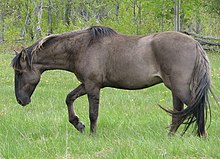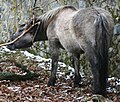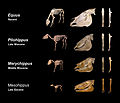Portal:Horses
The Horses PortalThe horse (Equus ferus caballus) is a domesticated, one-toed, hoofed mammal. It belongs to the taxonomic family Equidae and is one of two extant subspecies of Equus ferus. The horse has evolved over the past 45 to 55 million years from a small multi-toed creature, close to Eohippus, into the large, single-toed animal of today. Humans began domesticating horses around 4000 BCE, and their domestication is believed to have been widespread by 3000 BCE. Horses in the subspecies caballus are domesticated, although some domesticated populations live in the wild as feral horses. These feral populations are not true wild horses, which are horses that never have been domesticated and historically linked to the megafauna category of species. There is an extensive, specialized vocabulary used to describe equine-related concepts, covering everything from anatomy to life stages, size, colors, markings, breeds, locomotion, and behavior. Horses are adapted to run, allowing them to quickly escape predators, and possess an good sense of balance and a strong fight-or-flight response. Related to this need to flee from predators in the wild is an unusual trait: horses are able to sleep both standing up and lying down, with younger horses tending to sleep significantly more than adults. Female horses, called mares, carry their young for approximately 11 months and a young horse, called a foal, can stand and run shortly following birth. Most domesticated horses begin training under a saddle or in a harness between the ages of two and four. They reach full adult development by age five, and have an average lifespan of between 25 and 30 years. Horse breeds are loosely divided into three categories based on general temperament: spirited "hot bloods" with speed and endurance; "cold bloods", such as draft horses and some ponies, suitable for slow, heavy work; and "warmbloods", developed from crosses between hot bloods and cold bloods, often focusing on creating breeds for specific riding purposes, particularly in Europe. There are more than 300 breeds of horse in the world today, developed for many different uses. (Full article...) Entries here consist of Good and Featured articles, which meet a core set of high editorial standards.
 The first evidence of horses in warfare dates from Eurasia between 4000 and 3000 BC. A Sumerian illustration of warfare from 2500 BC depicts some type of equine pulling wagons. By 1600 BC, improved harness and chariot designs made chariot warfare common throughout the Ancient Near East, and the earliest written training manual for war horses was a guide for training chariot horses written about 1350 BC. As formal cavalry tactics replaced the chariot, so did new training methods, and by 360 BC, the Greek cavalry officer Xenophon had written an extensive treatise on horsemanship. The effectiveness of horses in battle was also revolutionized by improvements in technology, such as the invention of the saddle, the stirrup, and the horse collar. Many different types and sizes of horses were used in war, depending on the form of warfare. The type used varied with whether the horse was being ridden or driven, and whether they were being used for reconnaissance, cavalry charges, raiding, communication, or supply. Throughout history, mules and donkeys, as well as horses played a crucial role in providing support to armies in the field. (Full article...)Selected image Anatomy of a horse from a 9th century AH (15th century AD) Egyptian document at the University Library, Istanbul. Latest updates
More did you know?
Related portalsEntries here consist of Good and Featured articles, which meet a core set of high editorial standards.
The Sorraia is a rare breed of horse indigenous to the portion of the Iberian peninsula, in the Sorraia River basin, in Portugal. The Sorraia is known for its primitive features, including a convex profile and dun coloring with primitive markings. Concerning its origins, a theory has been advanced by some authors that the Sorraia is a descendant of primitive horses belonging to the naturally occurring wild fauna of Southern Iberia. Studies are currently ongoing to discover the relationship between the Sorraia and various wild horse types, as well as its relationship with other breeds from the Iberian Peninsula and Northern Africa. Members of the breed are small, but hardy and well-adapted to harsh conditions. They were occasionally captured and used by native farmers for centuries, and a remnant population of these nearly extinct horses was discovered by a Portuguese zoologist in the early 20th century. Today, the Sorraia has become the focus of preservation efforts, with European scientists leading the way and enthusiasts from several countries forming projects and establishing herds to assist in the re-establishment of this breed from its current endangered status. (Full article...)Did you know (auto-generated)
General imagesThe following are images from various horse-related articles on Wikipedia.
TopicsHorse • Pony • Asinus • Equus (genus) • Equidae • Zebra • Glossary of equestrian terms • List of horse breeds • Evolution of the horse • Domestication of the horse • Horse care • Stable • Horse training • Equestrianism • Horse tack • Saddle • Equine nutrition • Equine anatomy • Equine conformation • Equine coat color • Equine coat color genetics • Horse markings • Equine vision • Horse hoof • Horseshoe • Horse gait • Horse behavior • Horse breeding • Breed registry • Equine infectious anemia • Horse colic • Lameness • Laminitis • Horse slaughter • Horses in warfare • Arabian horse • Thoroughbred SubcategoriesNew articlesThis list was generated from these rules. Questions and feedback are always welcome! The search is being run daily with the most recent ~14 days of results. Note: Some articles may not be relevant to this project.
Rules | Match log | Results page (for watching) | Last updated: 2024-04-24 20:39 (UTC) Note: The list display can now be customized by each user. See List display personalization for details.
WikiProjectsAssociated WikimediaThe following Wikimedia Foundation sister projects provide more on this subject:
Discover Wikipedia using portals |



























































